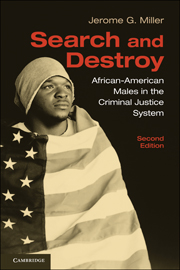1 - The Scope of the Problem
Published online by Cambridge University Press: 05 June 2012
Summary
Amid two decades of economic growth and social neglect, the white majority in America presented its inner cities with an expensive gift – a new and improved criminal justice system. It would, the government promised, bring domestic tranquility, with particular relevance to African-Americans. No expense was spared in crafting and delivering it inside the city gates. It proved to be a Trojan horse.
While neoconservative commentators such as Charles Murray argued that welfare had undermined family stability and sabotaged work incentives, the real value of Aid to Families with Dependent Children (AFDC) and food-stamp payments to the poor had steadily declined. Not so with criminal justice.
In a society obsessed with single mothers on welfare, more money ($31 billion) was being spent in 1993 at local, state, and federal levels on a failed drug war (mainly directed at African-American and Latino citizens) than on AFDC, that much vaunted symbol of liberal largesse ($25 billion). Moreover, the politics of crime and welfare came with a decidedly racial cast.
As governmental investment in social and employment programs in the inner city was held stable or reduced, a surfeit of “wars” on crime and drugs were ratcheted up to fill the void. The rationale (and generally accepted view) was that the nation was caught in the throes of an exponential rise in violent crime – largely attributable to the arrival of “crack.” Although reliable studies at the time found this premise highly questionable, it didn't matter.
Information
- Type
- Chapter
- Information
- Search and DestroyAfrican-American Males in the Criminal Justice System, pp. 1 - 10Publisher: Cambridge University PressPrint publication year: 2010
